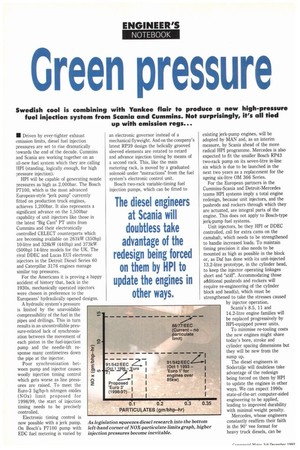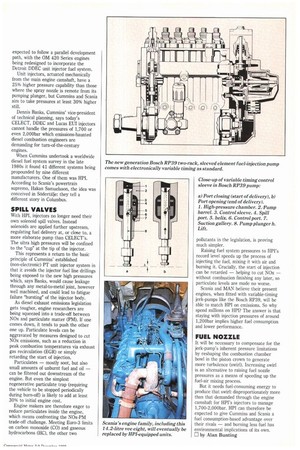Green pressure
Page 36

Page 37

If you've noticed an error in this article please click here to report it so we can fix it.
Swedish cool is combining with Yankee flair to produce a new high-pressure fuel injection system from Scania and Cummins. Not surprisingly, it's all tied up with emission regs...
• Driven by ever-tighter exhaust emission limits, diesel fuel injection pressures are set to rise dramatically towards the end of the decade. Cummins and Scania are working together on an all-new fuel system which they are calling HPI (standing, logically enough, for high pressure injection).
HPI will be capable of generating nozzle oressures as high as 2,000bar. The Bosch P7100, which is the most advanced European-style "jerk pump" currently fitted on production truck engines, achieves 1,200bar. It also represents a significant advance on the 1,500bar capability of unit injectors like those in the latest "Big Cam" PT units from Cummins and their electronically controlled CELECT counterparts which are becoming available on 261kW (350hp) 10-litre and 328kW (440hp) and 373kW (500hp) 14-litre models for the UK. The rival DDEC and Lucas EUI electronic injectors in the Detroit Diesel Series 60 and Caterpillar 3176 engines manage similar top pressures.
For the Americans it is proving a happy accident of history that, back in the 1930s, mechanically operated injectors were chosen in preference to the Europeans' hydraulically opened designs.
A hydraulic system's pressure is limited by the unavoidable compressibility of the fuel in the pipes and drillings. This in turn results in an uncontrollable pressure-related lack of synchronisation between the movement of each piston in the fuel-injection pump and the needle-lift response many centimetres down the pipe at the injector.
Poor synchronisation between pump and injector causes woolly injection timing control which gets worse as line pressures are raised. To meet the Euro-3 5g/hp-h nitrogen oxides (N0x) limit proposed for 1998/99, the start of injection timing needs to be precisely controlled.
Electronic timing control is now possible with a jerk pump. On Bosch's P7100 pump with EDC fuel metering is varied by an electronic governor instead of a mechanical flyweight. And on the company's latest RP39 design the helically grooved sleeved elements are rotated to retard and advance injection timing by means of a second rack. This, like the main metering rack, is moved by a graduated solenoid under "instructions" from the fuel system's electronic control unit.
Bosch two-rack variable-timing fuel injection pumps, which can be fitted to existing jerk-pump engines, will be adopted by MAN and, as an interim measure, by Scania ahead of the more radical HPI programme. Mercedes is also expected to fit the smaller Bosch RP43 two-rack pump on its seven-litre in-line six which is due to be launched in the next two years as a replacement for the ageing six-litre OM 366 Series.
For the European partners in the Cumrnins-Scania and Detroit-Mercedes teams HPI systems imply a total engine redesign, because unit injectors, and the pushrods and rockers through which they are actuated, are integral parts of the engine. This does not apply to Bosch-type jerk-pump fuel systems.
Unit injectors, be they HPI or DDEC controlled, call for extra cams on the camshaft, which needs to be strengthened to handle increased loads. To maintain timing precision it also needs to be mounted as high as possible in the block or, as Daf has done with its unit-injected 13.2-litre prototype, in the cylinder head, to keep the injector operating linkages short and "stiff'. Accommodating those additional pushrods and rockers will require re-engineering of the cylinder block and head(s), which must be strengthened to take the stresses caused by injector operation.
Scania's 8.5, 11 and 14.2-litre engine families will be replaced progressively by HPI-equipped power units.
To minimise re-tooling costs the new engines might share today's bore, stroke and cylinder spacing dimensions but they will be new from the sump up.
The diesel engineers in SOdertalje will doubtless take advantage of the redesign being forced on them by HPI to update the engines in other ways. We can expect 1990s state-of-the-art computer-aided engineering to be applied, leading to improved durability with minimal weight penalty.
Mercedes, whose engineers constantly reaffirm their faith in the 90° vee format for heavy truck diesels, can be expected to follow a parallel development path, with the OM 420 Series engines being redesigned to incorporate the Detroit DDEC unit injector fuel system.
Unit injectors, actuated mechanically from the main engine camshaft, have a 25% higher pressure capability than those where the spray nozzle is remote from its pumping plunger, but Cummins and Scania aim to take pressures at least 30% higher still.
Dennis Banks, Cummins' vice-president of technical planning, says today's CELECT, DDEC and Lucas EUI injectors cannot handle the pressures of 1,700 or even 2,000bar which emissions-haunted diesel combustion engineers are demanding for turn-of-the-century engines.
When Cummins undertook a worldwide diesel fuel system survey in the late 1980s it found 41 different systems being propounded by nine different manufacturers. One of them was HP!. According to Scania's powertrain
supremo, Hakan Samuelsson, the idea was conceived in SOdertalje: they tell a different story in Columbus.
SPILL VALVES
With HPI, injectors no longer need their own solenoid spill valves. Instead solenoids are applied further upstream, regulating fuel delivery at, or close to, a more elaborate pump than CELECT's. The ultra high pressures will be confined to the "cup" at the tip of the injector.
This represents a return to the basic principle of Cummins' established (non-electronic) PT unit injector system in that it avoids the injector fuel line drillings being exposed to the new high pressures which, says Banks, would cause leakage through any metal-to-metal joint, however well machined, and could lead to fatigue failure `bursting" of the injector body.
As diesel exhaust emissions legislation gets tougher, engine researchers are being squeezed into a trade-off between NOx and particulate matter (PM). If one comes down, it tends to push the other one up. Particulate levels can be aggravated by measures designed to cut NOx emissions, such as a reduction in peak combustion temperatures via exhaust gas recirculation (EGR) or simply retarding the start of injection.
Particulates — mostly soot, but also small amounts of unburnt fuel and oil — can be filtered out downstream of the engine. But even the simplest regenerative particulate trap (requiring the vehicle to be stopped periodically during burn-off) is likely to add at least 30% to initial engine cost.
Engine makers are therefore eager to reduce particulates inside the engine, which means confronting the NOx-PM trade-off challenge. Meeting Euro-3 limits on carbon monoxide (CO) and gaseous hydrocarbons (HC), the other two a) Port closing (start of delivery), b) Port opening (end of delivery).
1. High-pressure chamber. 2.-Pump barrel. 3. Control sleeve. 4. Spill port. 5. helix. 6. Control port. 7. Suction gallery. 8. Pump plunger h. Lift.
pollutants in the legislation, is proving much simpler.
Raising fuel system pressures to HPI's record level speeds up the process of injecting the fuel, mixing it with air and burning it. Crucially, the start of injection can be retarded — helping to cut NOx — without combustion finishing any later, so particulate levels are made no worse.
Scania and MAN believe their present engines, when fitted with variable-timing jerk-pumps like the Bosch RP39, will be able to match HPI on emissions. So why spend millions on HPI? The answer is that staying with injection pressures of around 1,200bar implies higher fuel consumption and lower performance.
FUEL NOZZLE
It will be necessary to compensate for the jerk-pump's inherent pressure limitations by reshaping the combustion chamber bowl in the piston crown to generate more turbulence (swirl). Increasing swirl is an alternative to raising fuel nozzle pressures as a means of speeding up the fuel-air mixing process.
But it needs fuel-consuming energy to produce that swirl: disproportionately more than that demanded through the engine camshaft for HPI's injectors to manage 1,700-2,000bar. HPI can therefore be expected to give Cummins and Scania a fuel consumption-based advantage over their rivals — and burning less fuel has environmental implications of its own. El by Alan Bunting












































































